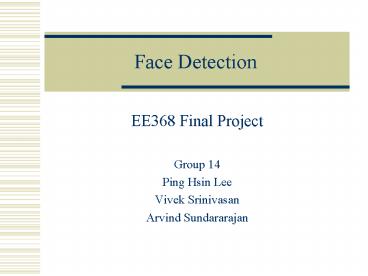Face Detection - PowerPoint PPT Presentation
Title:
Face Detection
Description:
Face Detection EE368 Final Project Group 14 Ping Hsin Lee Vivek Srinivasan Arvind Sundararajan Overview Introduction Methods used to detect faces Color segmentation ... – PowerPoint PPT presentation
Number of Views:104
Avg rating:3.0/5.0
Title: Face Detection
1
Face Detection
- EE368 Final Project
- Group 14
- Ping Hsin Lee
- Vivek Srinivasan
- Arvind Sundararajan
2
Overview
- Introduction
- Methods used to detect faces
- Color segmentation
- Morphological Processing
- Template Matching And Clustering
- Results
- Techniques considered but not used
3
Color Segmentation
- Use color information in the YCbCr domain
- YCbCr Color space effectively decorrelates the
intensity and color information - Each channel information is represented in
discrete levels.
4
MAP Rule
- Implement MAP decoder to determine skin from
non-skin pixels - D(I(x,y)) 1 if P(I(x,y) S)P(S) gt T P(I(x,y)
NS)P(NS) - 0 other wise
- Minimizes misclassification error
5
Result of Color Segmentation
6
Morphological Processing
- Reject blobs of small sizes, perform closing,
remove holes
7
Non-face Object Removal
- Use information about shape and location of
objects in conjunction to reject non-face objects
while minimizing rejection of faces - Objects characterized by ?max/?min as a measure
of length. (Independent of size, translation, and
rotation of objects)
Example of non-face object removed by CCA
8
Non-face Object Removal
Before and after rejection
9
Template Matching
- Performed in the luminance domain using the FFT
- First attempt use the average of all face
regions - Features did not seem to align properly, hence
this template was rejected
Rejected Template
10
Final Templates Used
- Resample each face region to the same size before
averaging. - Include mirror images of each face region to
produce a symmetric template (a). - In addition, a non-symmetric partial template (b)
is used to capture information about smaller and
partially obscured faces in the image - One template tests for symmetry, while the other
tests for non-uniform illumination, and captures
smaller faces as well.
11
Clustering of Correlation Peaks
- The autocorrelation results for each template
were first thresholded and then combined. - Used heuristic techniques based on shape of the
skin regions to group peaks. - Any 2 peaks meeting a maximum distance criterion
and connected by a line passing through only skin
regions were grouped together as a face.
12
Results of Grouping Correlation Peaks
- Before and after peak grouping
13
Results Applied to the Original Image
- Image corresponding to the grouped peaks
14
Final Results
Image 1 2 3 4 5 6 7
Score 20 22 24 22 24 24 21
Total 21 24 25 24 24 24 22
15
Techniques Considered but not Used
- Fishers linear discriminant (FLD)
- Poor performance in rejection of false positives
because detected non-face and face regions are
not linearly separable - Eigenfaces
- Produced results similar to template matching but
at an increased computational cost
16
Techniques Considered but not Used
- Support Vector Machines (SVM)
- Generated 470 face regions and 500 non-face
regions each of size 49x55 pixels as training
database - Employed a Gaussian radial basis function (RBF)
as kernel
17
Samples of database images
- Faces
- Non-faces
18
Results of SVM
- Produced decision regions that are too tightly
bound to the training face samples and were not
able to classify the faces in the other training
pictures - Including the SVM in the program would only slow
down our runtime and would not produce noticeable
improvements
19
Conclusion
- Color segmentation in the YCbCr domain and
morphological processing produced good estimates
of face regions - Implemented multi-resolution template matching
and peak clustering to further distinguish
different face regions from each other and from
non-face regions - Could have done more to reject false positives
(MRC/neural networks to reject hand regions)
20
(No Transcript)
21
(No Transcript)































